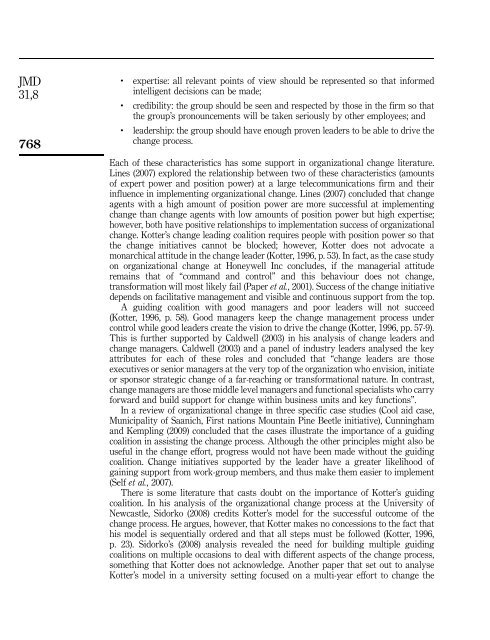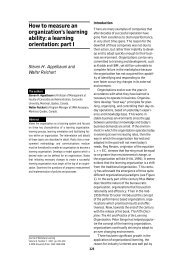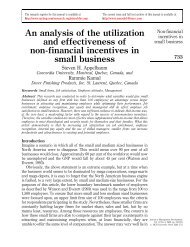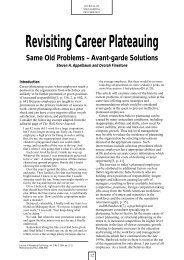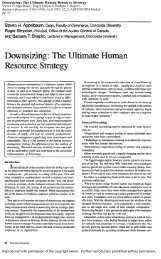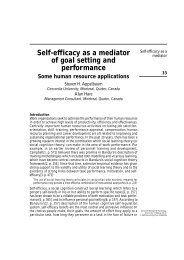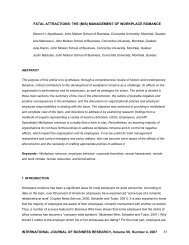Back to the future: revisiting Kotter's - Dr. Steven H. Appelbaum ...
Back to the future: revisiting Kotter's - Dr. Steven H. Appelbaum ...
Back to the future: revisiting Kotter's - Dr. Steven H. Appelbaum ...
You also want an ePaper? Increase the reach of your titles
YUMPU automatically turns print PDFs into web optimized ePapers that Google loves.
JMD<br />
31,8<br />
768<br />
.<br />
expertise: all relevant points of view should be represented so that informed<br />
intelligent decisions can be made;<br />
.<br />
credibility: <strong>the</strong> group should be seen and respected by those in <strong>the</strong> firm so that<br />
<strong>the</strong> group’s pronouncements will be taken seriously by o<strong>the</strong>r employees; and<br />
.<br />
leadership: <strong>the</strong> group should have enough proven leaders <strong>to</strong> be able <strong>to</strong> drive <strong>the</strong><br />
change process.<br />
Each of <strong>the</strong>se characteristics has some support in organizational change literature.<br />
Lines (2007) explored <strong>the</strong> relationship between two of <strong>the</strong>se characteristics (amounts<br />
of expert power and position power) at a large telecommunications firm and <strong>the</strong>ir<br />
influence in implementing organizational change. Lines (2007) concluded that change<br />
agents with a high amount of position power are more successful at implementing<br />
change than change agents with low amounts of position power but high expertise;<br />
however, both have positive relationships <strong>to</strong> implementation success of organizational<br />
change. Kotter’s change leading coalition requires people with position power so that<br />
<strong>the</strong> change initiatives cannot be blocked; however, Kotter does not advocate a<br />
monarchical attitude in <strong>the</strong> change leader (Kotter, 1996, p. 53). In fact, as <strong>the</strong> case study<br />
on organizational change at Honeywell Inc concludes, if <strong>the</strong> managerial attitude<br />
remains that of “command and control” and this behaviour does not change,<br />
transformation will most likely fail (Paper et al., 2001). Success of <strong>the</strong> change initiative<br />
depends on facilitative management and visible and continuous support from <strong>the</strong> <strong>to</strong>p.<br />
A guiding coalition with good managers and poor leaders will not succeed<br />
(Kotter, 1996, p. 58). Good managers keep <strong>the</strong> change management process under<br />
control while good leaders create <strong>the</strong> vision <strong>to</strong> drive <strong>the</strong> change (Kotter, 1996, pp. 57-9).<br />
This is fur<strong>the</strong>r supported by Caldwell (2003) in his analysis of change leaders and<br />
change managers. Caldwell (2003) and a panel of industry leaders analysed <strong>the</strong> key<br />
attributes for each of <strong>the</strong>se roles and concluded that “change leaders are those<br />
executives or senior managers at <strong>the</strong> very <strong>to</strong>p of <strong>the</strong> organization who envision, initiate<br />
or sponsor strategic change of a far-reaching or transformational nature. In contrast,<br />
change managers are those middle level managers and functional specialists who carry<br />
forward and build support for change within business units and key functions”.<br />
In a review of organizational change in three specific case studies (Cool aid case,<br />
Municipality of Saanich, First nations Mountain Pine Beetle initiative), Cunningham<br />
and Kempling (2009) concluded that <strong>the</strong> cases illustrate <strong>the</strong> importance of a guiding<br />
coalition in assisting <strong>the</strong> change process. Although <strong>the</strong> o<strong>the</strong>r principles might also be<br />
useful in <strong>the</strong> change effort, progress would not have been made without <strong>the</strong> guiding<br />
coalition. Change initiatives supported by <strong>the</strong> leader have a greater likelihood of<br />
gaining support from work-group members, and thus make <strong>the</strong>m easier <strong>to</strong> implement<br />
(Self et al., 2007).<br />
There is some literature that casts doubt on <strong>the</strong> importance of Kotter’s guiding<br />
coalition. In his analysis of <strong>the</strong> organizational change process at <strong>the</strong> University of<br />
Newcastle, Sidorko (2008) credits Kotter’s model for <strong>the</strong> successful outcome of <strong>the</strong><br />
change process. He argues, however, that Kotter makes no concessions <strong>to</strong> <strong>the</strong> fact that<br />
his model is sequentially ordered and that all steps must be followed (Kotter, 1996,<br />
p. 23). Sidorko’s (2008) analysis revealed <strong>the</strong> need for building multiple guiding<br />
coalitions on multiple occasions <strong>to</strong> deal with different aspects of <strong>the</strong> change process,<br />
something that Kotter does not acknowledge. Ano<strong>the</strong>r paper that set out <strong>to</strong> analyse<br />
Kotter’s model in a university setting focused on a multi-year effort <strong>to</strong> change <strong>the</strong>


